"Integrated management platform" topics
What Is an Integrated Management Platform?
With the acceleration of shorter product/data life cycles, it has become necessary to create a virtuous cycle in which the results obtained from R&D (research data, development equipment, etc.) are maximized in their value as early as possible and used to enhance the next investment and go-to-market strategy.
The Integrated Management Platform manages remote systems and measurement data in an integrated manner, standardizing everything from measurement system status monitoring to automatic software updates, remote system sharing and collaboration, automatic processing of measurement/analysis data, and report output. This will directly lead to the mutual utilization of resources inside and outside the organization (testing systems and other facilities, data, technology, human resources, etc.), more efficient R&D operations, and a shorter R&D cycle, dramatically improving the challenge, competition, and promotion of the project.
Sky technology uses SystemLink, which is open, scalable, and flexible, as its basic software to build an Integrated Management Platform with short delivery time, low cost, and low risk.

Functions of an Integrated Management Platform
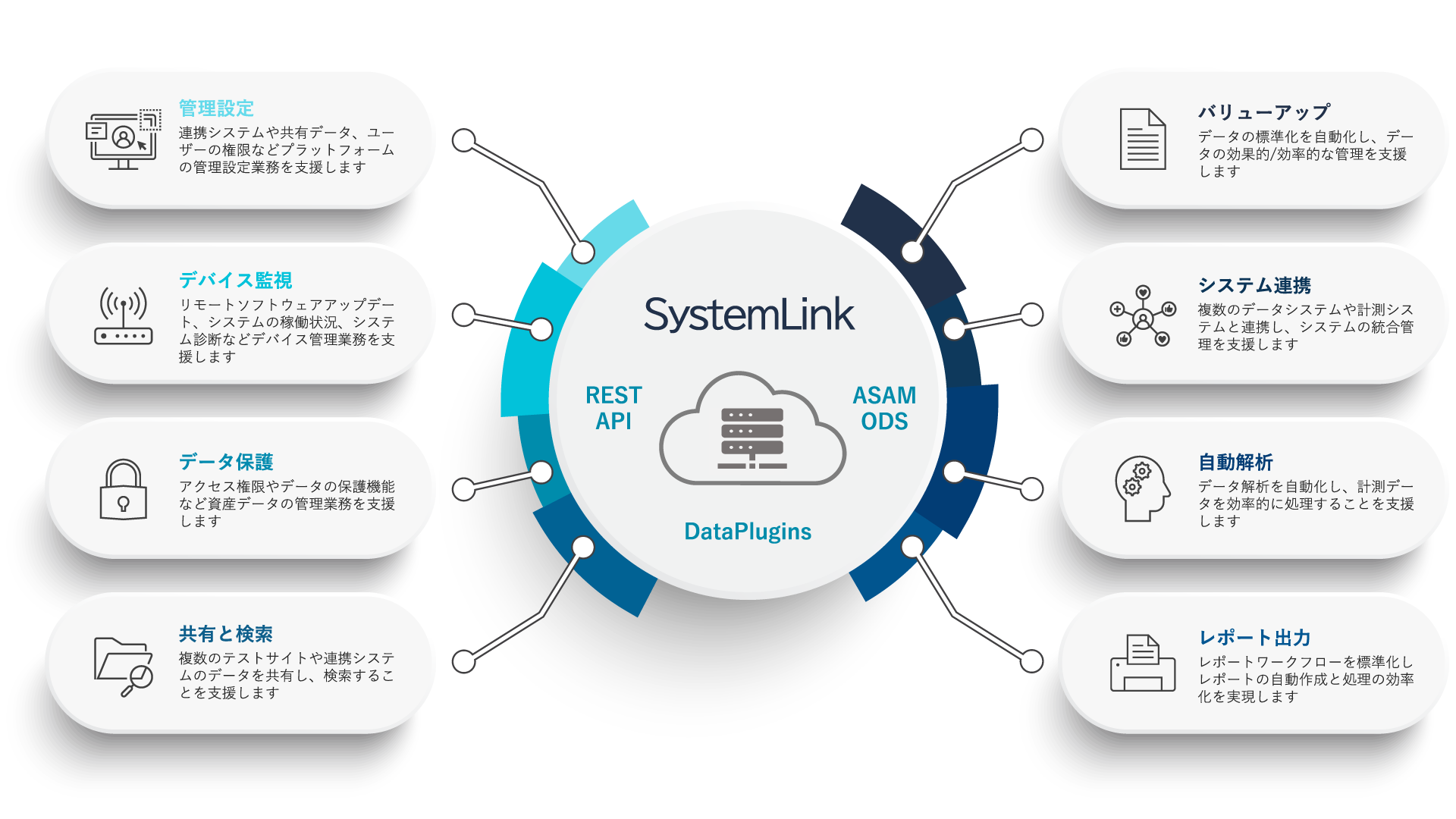
This integrated management platform has the following functions.
〇 Administrative Assistant ・・・ Remotely monitor, manage, and configure equipment and data servers in remote locations
〇 Automation of Operations ・・・ Automatically execute measurement, analysis, and reporting tasks according to conditions
〇 Data Protection ・・・ Set user/administrator limits, delete, overwrite, search permissions, etc.
〇 Data Standardization ・・・ Data preprocessing, including validity (e.g., missing/abnormal values) checks, metadata assignment, unit conversion, statistical calculations, and format conversion
〇 System Sharing/Collaboration ・・・ Share resources (equipment, data, technology, human resources) within and outside the group to effectively and efficiently utilize assets (data and systems)
Importance of Data Management
〇 Anti-Fraud Measures
In order to ensure the transparency of processes and the reproducibility and reliability of data, many institutions, including companies, universities, and research institutes, have established guidelines for data management and, where necessary, regulations requiring data disclosure. Many organizations are required to store digitized data in a reusable form by organizing and managing metadata and backing it up appropriately.
〇 Open Innovation
In addition to shortening the R&D cycle and improving the efficiency of R&D operations, open innovation initiatives that mutually utilize external resources such as technology, information, and human resources have become increasingly important. By standardizing and structuring all data and quickly developing an environment that makes it easy to search, download, and reuse data, it is expected to effectively utilize resources inside and outside the organization, increase the speed of innovation, and reduce R&D costs and risks.
〇 Policies of Research Funding Agencies
Submission of research data management plans by national and international research funding agencies is now mandatory. In Japan, the basic stance of the government is to " expand the utilization of publicly funded research results as much as possible," and research data management is a requirement for obtaining research funding.
How to Build Without Failure
System and data integration management platforms are prone to problems and require attention because of the wide variety of purposes for which they can be deployed, the scope of their users, and the surprisingly rapid development of IoT technologies.

- Too many users to determine specifications. Specifications change during development.
- No cooperation from other departments/groups to share and collaborate.
- The time to implementation is long, and the issues to be solved and objectives gradually become out of sync with the specifications.
- Although the system was highly effective immediately after its introduction, it gradually became unused as the number of users decreased.
To avoid these problems, the following measures are effective.
【Effective measures】- start with the most effective and understandable implementation part.
- Start by setting simple objectives and tasks, and start small to build successful cases.
- Emphasis will be placed on speed and drive of development to achieve immediate implementation benefits.
- Keep all users informed of the purpose and issues of the introduction and maintain a consensus within the organization.
- Extend the lifecycle of the platform through continuous evaluation and improvement/extension by all users.
Let's Start Small!
The benefits and value of an Integrated Management Platform tend to increase with the size of the system and its users, and with the speed at which it is implemented and updated. However, designing a large-scale platform from the outset by summarizing the objectives and issues of all users takes a tremendous amount of time and manpower, and is impractical. In addition, it is possible that new IoT technologies will have been created in six months, and considering that the needs for the platform will change slightly depending on the level of commitment and usage by user organizations, designing and building a perfect platform in a single step that can be used efficiently for a long period of time with no loss of convenience is a big risk.
If the platform is of high use, it is inevitable that expectations will gradually rise both within and outside the organization, and that it will be improved and expanded in the near future. As small success cases are established and the value of the system is recognized among users and inside and outside the organization, the need for improvements and extended functions in the next phase will rise one after the other. In addition, once the top management recognizes the utility value of the system, it becomes easier to secure budget and manpower for development, which dramatically increases the project's momentum.
In order to proceed smoothly from planning to budgeting, development, and implementation without major problems, it is necessary to share the future vision, purpose, and usage of the platform from the top management to the user level, and to reach a consensus among everyone. It is recommended to start with the most effective functions that are easy to implement and realize the benefits, and then add functions according to the usage status, and gradually expand and improve them according to the level of the organization's efforts.

Lifetime of Integrated Management Platform
An integrated management platform can be improved and extended by identifying needs and problems in a short cycle to maintain maximum effectiveness.
While it is easy to secure budgets and manpower for improvements and expansions for projects that proceed top-down, budgets and manpower for projects that proceed bottom-up from end-users tend to be inadequate until a successful case is made. In addition, even when a sufficient budget is available, it makes sense to "start small and build successful cases" in order to achieve consensus and smooth implementation. However, despite a small start, the implementation may not work. It is when a system is not successfully placed on the expansion and improvement cycle that is essential to extend its life cycle, resulting in a limited number of users or a drop in frequency of use.
The two main causes are as follows.
①The system is not flexible and scalable, and cannot be improved or expanded in a short period of time and at a low cost.
②It takes too much time from planning to implementation, and specifications and requirements change during implementation, making it insufficiently effective.
These are problems with the flexibility and scalability of the installed system and how it is constructed.
In order to build an Integrated Management Platform with a long lifetime, it is important to fully consider how to build the system, its flexibility, and scalability, taking into account the shortened development cycle and the cost of improvement and expansion.
How to Choose an Integrated Management Platform
As shown in the figure, the Integrated Management Platform consists of a doughnut-shaped center with the main function of "data indexing and mining," which is surrounded by various additional functions for integrated data management, such as preprocessing, integration with other systems, automatic analysis, report output, sharing and data retrieval, data protection, device monitoring, and management setting.
There are three main ways to build an Integrated Management Platform.
【Full order method】
Even if there are special requests, as long as there are no technical or physical constraints, you can obtain something that fits the purpose and requirements, but it is very costly, time-consuming, and manpower-intensive.
【Semi order method】
This method is based on a system that has been prepared in advance and is built up to meet the requirements. Since there are many parts that must be made exclusively for this method, it requires a certain amount of cost and time. However, if there are no special requests, it is possible to create a system that perfectly meets the requirements.
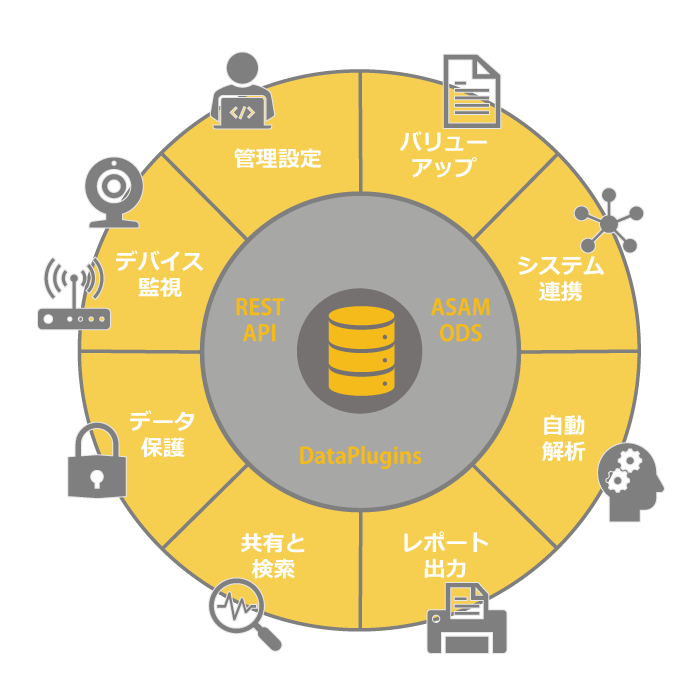
【Parts order method】
Only the necessary functions are selected, and only those areas not supported by general-purpose software are customized. Cost and time are minimized because only the necessary parts are customized to meet your requirements.
It is easy to follow trends because the implementation time is short. In addition, the software used is often highly versatile, making it highly scalable and flexible. Because of the minimal start, there are also advantages such as easier budget application and consensus.
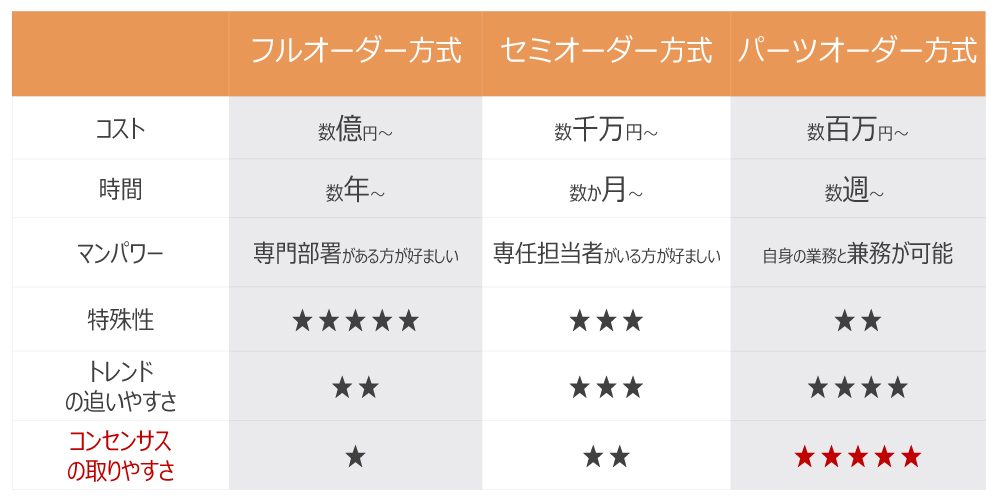
The table above compares cost, time, manpower, special characteristics, ease of following trends, and ease of consensus by method.
Which method is best depends on the required functions and scale, but we recommend the semi-custom or parts-order method unless the product is so special that it cannot be realized.
If you have a software or system that meets your objectives, we recommend the parts order method because it is less costly and time-consuming, and it is easier to follow trends. In addition, the limited number of parts to be created exclusively makes it easy to reach a consensus and prevents problems during and after implementation.
Function of SystemLink
The features of the NI SystemLink 2020 R1 are listed in the table below.
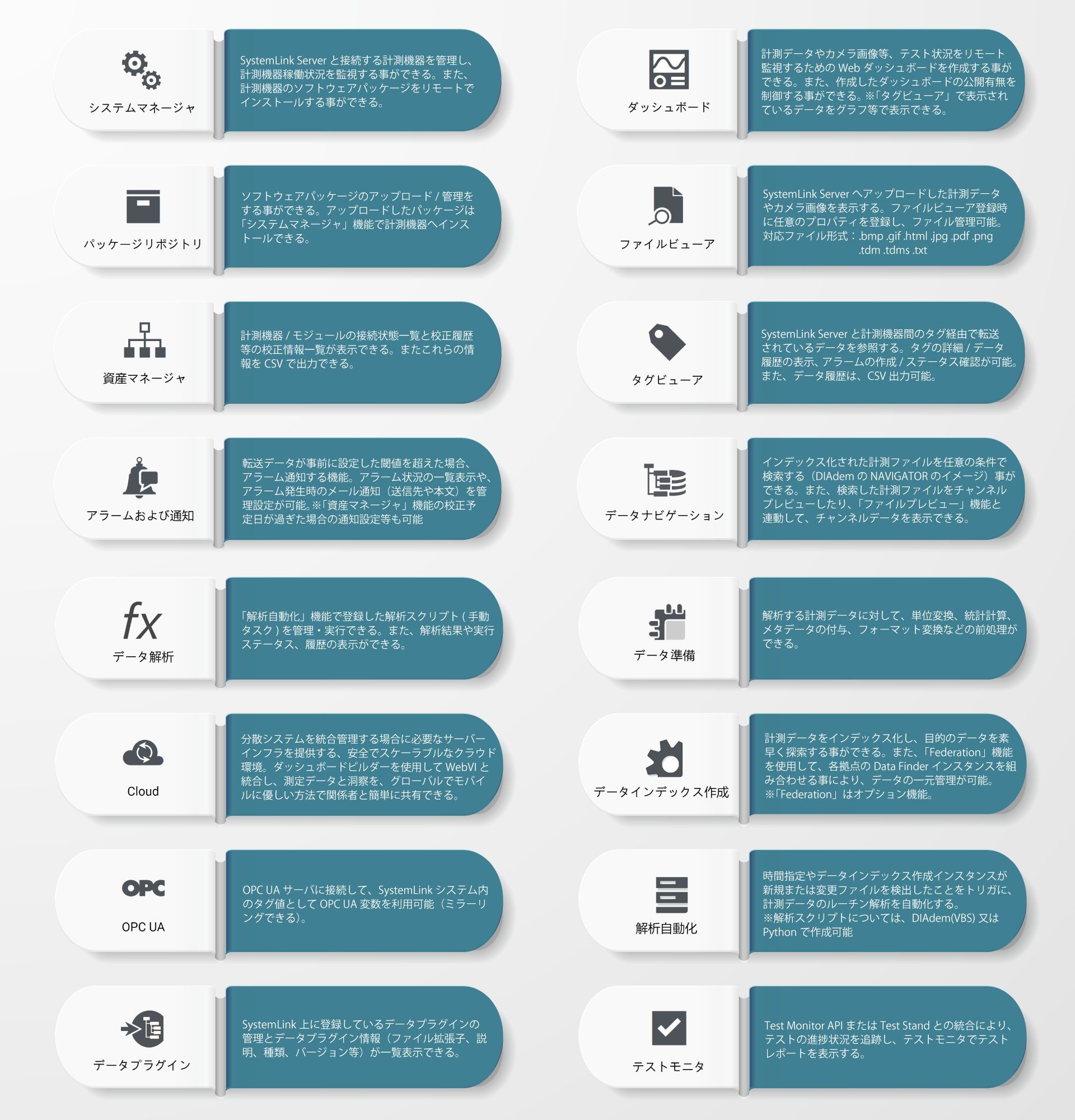
System Requirements for SysytemLink
The system requirements for the NI SystemLink 2020 R1 are shown in the table below.
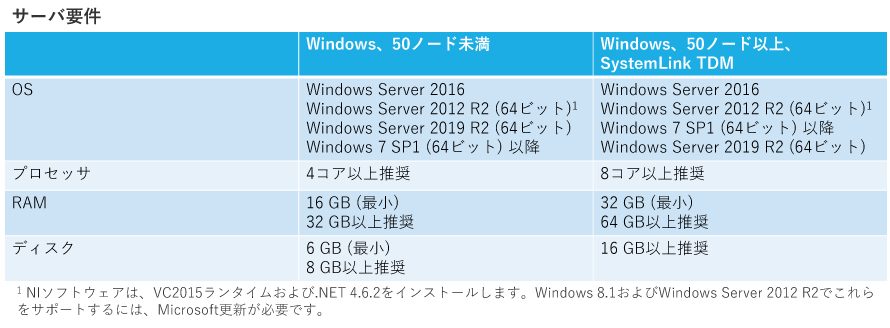

Example of Platform Construction ①
In addition to device monitoring and diagnostic functions, SystemLink has modules that enable data preprocessing, indexing and mining, and analysis. In addition, a dedicated WebUI for data retrieving, downloading, and uploading data, REST API for integration with many third-party products and systems, and numerous DataPlugins are provided.
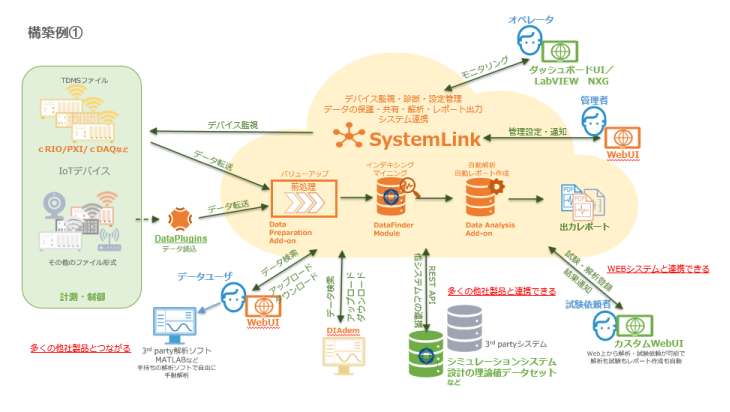
The green areas are functions that we will develop.
First, the measurement part. If your instrument is not a NI product and you do not have DataPlugins ready, create dedicated DataPlugins.
Then, a monitoring dashboard UI for monitoring and diagnostics of the instrumentation is made to be ready for immediate use.
It is also possible to exchange data with other companies' products using REST API, develop other measurement systems, etc., and link them to the data sets of simulation systems.
Next is the custom WebUI. Once an analysis or test request is registered on the Web, everything from measurement, data preprocessing, data storage, analysis, report generation, and results/diagnostic notifications is performed automatically. And of course, if you want to analyze manually, you can search, download, and upload your data.
Web systems can be used from anywhere without special software, and can be tailored to the customer's requirements of how they want to use the system.

